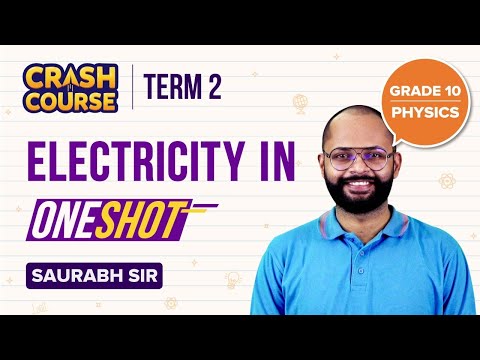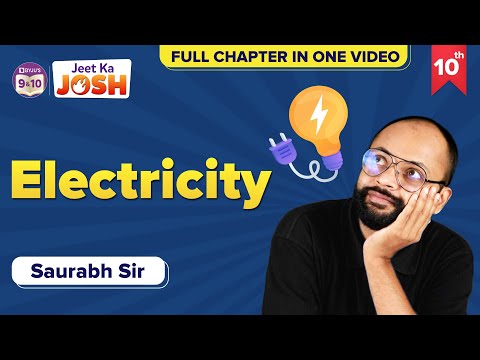Electrical energy is an important concept in science, yet it is frequently misunderstood. So what exactly is electrical energy and what are some of the rules applied when it is used in calculations? In this article, let us find answers to these questions.
| Table of Contents: |
What Is Electrical Energy?
Electrical energy is the energy derived from electric potential energy or kinetic energy of the charged particles. In general, it is referred to as the energy that has been converted from electric potential energy. We can define electrical energy as the energy generated by the movement of electrons from one point to another. The movement of charged particles along/through a medium (say wire) constitute current or electricity.

Electrical Energy Formula
A cell has two terminals – a negative and a positive terminal. The negative terminal has the excess of electrons whereas the positive terminal has a deficiency of electrons. Let us take the positive terminal as A and the electrical potential at A is given by V(A). Similarly, the negative terminal is B and the electrical potential at B is given by V(B). Electric current flows from A to B, and thus V(A) > V (B).
The potential difference between A and B is given by
V = V(A) – V(B) > 0
Mathematically, electric current is defined as the rate of flow of charge through the cross-section of a conductor.
Thus, it is given by I = ∆Q/ ∆t where I is the electric current and ∆Q is the quantity of electric charge flowing through a point in time ∆t.
The potential energy of charge Q at A is Q V(A) and at B, it is Q V(B). So the change in the potential energy is given by
∆Upot = Final potential energy – Initial potential energy
= ∆Q [(V (B) – V (A)] = –∆Q V
= –I V∆t (Since I = ∆Q/ ∆t)
If we take the kinetic energy of the system into account, it would also change if the charges inside the conductor moved without collision. This is to keep the total energy of the system unchanged. Thus, by conservation of total energy, we have:
∆K = –∆Upot
Or ∆K = I V∆t > 0
Thus, in the electric field, if the charges move freely across the conductor, there would be an increase in the kinetic energy as they move.
When the charges collide, the energy gained by them is shared between the atoms. Consequently, the vibration of the atoms increases resulting in the heating up of the conductor. Thus, some amount of energy is dissipated in the form of heat in an actual conductor.
Units of Electrical Energy
The basic unit of electrical energy is the joule or watt-second. An electrical energy is said to be one joule when one ampere of current flows through the circuit for a second when the potential difference of one volt is applied across it. The commercial unit of electrical energy is the kilowatt-hour (kWh) which is also knwon as the Board of trade unit (B.O.T).
1 kwh = 1000 × 60 × 60 watt – second
1 kwh = 36 × 105 Ws or Joules
Generally, one kwh is called one unit.
What Are Some Examples of Electrical Energy?
A few examples of electrical energy are:
- In a car battery, a chemical reaction results in the formation of an electron which possesses the energy to move in an electric current. These moving charges provide electrical energy to the circuits in the car.
- Lightning, during a thunderstorm, is an example of electrical energy – what we see as lightning is nothing but electricity discharging in the atmosphere.
- Electric eels generate electrical energy and use it against predators for defence.
Why shouldn’t you touch electrical equipment with wet hands? Find out answer to this question by watching the video.

Electrical Energy Into Mechanical Energy
Electrical energy can be converted into other forms of energy like heat energy, light energy, motion etc. The best-known example are:
- Fan: The motor in Fan converts electrical energy into mechanical energy
- Bulb: Here the electrical energy is converted into light energy.
Summary
Some of the keynotes on electrical energy is tabulated below
|
Definition |
Electrical energy can be due to either kinetic energy or potential energy. Mostly it is due to potential energy, which is energy stored due to the relative positions of charged particles or electric fields. |
|
Symbol |
E |
|
Units |
Joule (J) |
|
Kilowatt-hour(kWh) |
|
|
Electron-Volt(eV) |
|
|
Formula |
E = QV Q is charge V is the potential difference |
|
Examples |
Electrical charges moving through a wire or electricity. |
|
Lightning. |
|
|
Batteries. |
|
|
Static electricity. |
|
|
Electric wheels generate electrical energy. |
|
|
Electricity stored in capacitors. |
|
|
Audio speakers. |
|
|
Doorbells. |
|
|
Uses |
Lighting, cooling, heating. Operating appliances, electronics, computers, machinery. Public transportation systems. |
|
Facts |
Electricity travels at the speed of light that is more than 186,000 miles per second. |
|
A spark of static electricity can measure up to 3,000 volts. |
|
|
A bolt of lightning can measure up to 3,000,000 volts and it lasts less than one second. |
What Is Electric Power?
Electric power Definition – It is the rate at which work is done or energy is transformed in an electrical circuit. Simply put, it is a measure of how much energy is used in a span of time.
In physics, the rate of transfer of electrical energy by an electrical circuit per unit time is called electrical power. Here electrical energy can be either kinetic energy or potential energy. In most of the cases, potential energy is considered, which is the energy stored due to the relative positions of charged particles or electric fields. Electrical power is denoted by P and measured using Watt.
|
Symbol |
P |
|
SI Unit |
Watt, joule per second |
|
Scalar or Vector |
Scalar Quantity |
|
Formula |
P=VI Where, V is the potential difference (volts) I is the electric current |
We talked about the energy that is dissipated due to the heating up of the conductor. The energy dissipated in time interval ∆t is given by
∆W = I V∆t
And the energy dissipated per unit time is actually the power dissipated, which is given by P = ∆W/∆t. But we know the formula for power is given by P = I V
Hence, according to Ohm’s law, V = IR. Substituting we have,
P = I2R
Or
P = V2/R
It is this power which is responsible for heating up the coil of a bulb, which gives out heat and light.
Related Physics Concepts:
- Relation Between Power And Resistance
- Relation Between Electric Field And Electric Potential
- Dielectric Properties – Terminology, Mechanism, Applications
- Relation Between eV And Joule
The below videos help to revise the chapter Electricity Class 10
 |
 |
Frequently Asked Questions – FAQs
Define electrical energy.
Write the units fo electrical energy.
The units of electrical energy are joules, kilowatt-hour, and electron-volt.
Write the uses of electrical energy.
What is the speed of electricity?
What constitutes electricity?
Define electric Power.
Write the SI unit of electric power.
The SI unit of electric power is watt.
Write the electric power formula and explain the terms.
The electric power is given by P = VI.
Where,
V is the potential difference, I is the electric current and P is the electric power.
Is electric power a scalar quantity or vector quantity?
How can we express power using Ohms law?
Where V is the potential difference, I is the electric current, R is the resistance and P is the electric power.
Hope you have understood Electric energy and power, How it is defined, its Symbol, Units, Formula, and Terms. For a better understanding of current electricity, do read the related articles and answer the practice questions.
Stay tuned with BYJU’S for more such interesting articles. Also, register to “BYJU’S-The Learning App” for loads of interactive, engaging physics-related videos and unlimited academic assistance.

Really helpful notes